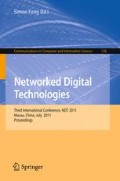Abstract
A recent paradigm shift has broadly impacted the evolution of electronic government: Gov 2.0. This shift represents a massive change from a static web presence for the delivery of information and services to using collaborative web technologies to engage citizens, foster co-production, and encourage transparency in government. Social media are creating new pathways between citizens and government to access information and services. The author argues that by applying Diffusion of Innovation, Social Influence, and Collective Intelligence theories, one can better understand how Gov 2.0 technologies and applications are adopted and may enable transformative changes in the delivery of online government information and services. U.S. federal government initiatives adopting social media are examined. These observations demonstrate how interactions between citizens and government are changing and creating entirely new online communities that defy traditional communication reach and organizational boundaries. Challenges and barriers to achieving open government initiatives are presented. Recommendations are offered.
Access this chapter
Tax calculation will be finalised at checkout
Purchases are for personal use only
Preview
Unable to display preview. Download preview PDF.
References
Anonymous. Open Government Public Engagement Tool. U.S. Government Service Administration (April 12, 2010), http://www.gsa.gov/Portal/gsa/ep/contentView.do?contentType=GSA_BASIC&contentId=29495
Atlee, T., Por, G.: Collective intelligence as a field of multi-disciplinary study and practice (2000), http://www.community-intelligence.com/files/Atlee%20-%20Por%20-%20CI%20as%20a%20Field%20of%20multidisciplinary%20study%20and%20practice%20.pdf
Campbell, S., Flagg, R.: Putting Citizens First: Transforming Online Government (November 2008), http://www.usa.gov/webcontent/documents/Federal_Web_Managers_WhitePaper.pdf
Campbell, S., Flagg, R.: Putting Citizens First: Transforming Online Government 2010 Progress Report (April 2010), http://www.usa.gov/webcontent/documents/2010_FWMC_AnnualProgressReport.pdf
Chang, M., Kannan, P.: Leveraging Web 2.0 in government. IBM Center for the Business of Government (2008), http://www.businessofgovernment.ort/pdfs/ChangReport2.pdf
Cialdini, R.B.: The science of persuasion. Scientific American 284, 76–81 (2001)
Data. Gov. (June 14, 2010), http://www.data.gov/
Deutsch, M., Gerard, H.B.: A study of normative and informational social influences upon individual judgment. Journal of Abnormal and Social Psychology 51, 629–636 (1955)
Flew, T.: New Media an Introduction. Oxford University Press, Melbourne (2008)
Godwin, B. Open Government, Transparency, and Social Media: A slide presentation (April 1, 2009), http://www.usa.gov/webcontent/resources/previousnewmediatalks.html
Godwin, B.: Matrix of Web 2.0 technology and government. USA.gov and Web best practices, GSA Office of Citizen Services (2008), http://www.usa.gov/webcontent/documents/Web_Technology_Matrix.pdf
Godwin, B., Campbell, S., Levy, J., Bounds, J.: Social media and the federal government: Perceived and real barriers and potential solutions. Federal Web Managers Council (December 2008), http://www.usa.gov/webcontent/documents/SocialMediaFed%20Govt_BarriersPotentialSolutions.pdf
Godwin, B., Campbell, S., Levy, J., Bounds, J.: Examples of agencies using online content and technology to achieve mission and goals. Federal Web Managers Council (2008), http://www.usa.gov/webcontent/documents/ExamplesofUsingTechnologyandContenttoAchieve%20Agency.pdf
Kelman, H.: Compliance, identification, and internalization: Three processes of attitude change. Journal of Conflict Resolution 1, 51–60 (1958)
Meijer, A., Thaens, M.: Alignment 2.0: Strategic use of new internet technologies in government. Government Information Quarterly 27, 113–121 (2010)
Obama, B.: Memorandum for the Heads of Executive Departments and Agencies: Transparency and Open Government (January 21, 2009), http://www.whitehouse.gov/the_press_office/Transparency_and_Open_Government/
O’Reilly, T.: Government as a Platform. In: Lathrop, D., Ruma, L.R.T. (eds.) Open Government: Transparency, collaboration and Participation in Practice, pp. 1–23. O’Reilly Media, Inc., Sebastopol (2010), http://opengovernment.labs.oreilly.com/cho1html
Osimo, D.: Web 2.0 in government: Why and how? European Commission Joint Research Center (2008), http://ftp.jrc.es/EURdoc/JRC45269.pdf
Pew Internet and American Life Project. Generations online in 2009 (December 2009), http://www.pewinternet.org
Rogers, E.M., Shoemaker, F.: Communication of Innovations: A Cross-Cultural Approach, 2nd edn. Free Press, New York (1971)
Smith, A.: Government Online: The Internet gives citizens new paths to government services and information (April 27, 2010), http://www.pewinternet.org
White House. Open government: A progress report to the American people (2009), http://www.whitehouse.gov
Wigand, R.T.: Web 2.0: Disruptive technology or is everything miscellaneous? In: Huizing, A., de Vries, E.J. (eds.) Information Management: Setting the Scene., pp. 269–284. Elsevier Scientific Publishers, Amsterdam (2007)
Author information
Authors and Affiliations
Editor information
Editors and Affiliations
Rights and permissions
Copyright information
© 2011 Springer-Verlag Berlin Heidelberg
About this paper
Cite this paper
Lux Wigand, F.D. (2011). Gov 2.0 and Beyond: Using Social Media for Transparency, Participation and Collaboration. In: Fong, S. (eds) Networked Digital Technologies. NDT 2011. Communications in Computer and Information Science, vol 136. Springer, Berlin, Heidelberg. https://doi.org/10.1007/978-3-642-22185-9_26
Download citation
DOI: https://doi.org/10.1007/978-3-642-22185-9_26
Publisher Name: Springer, Berlin, Heidelberg
Print ISBN: 978-3-642-22184-2
Online ISBN: 978-3-642-22185-9
eBook Packages: Computer ScienceComputer Science (R0)

